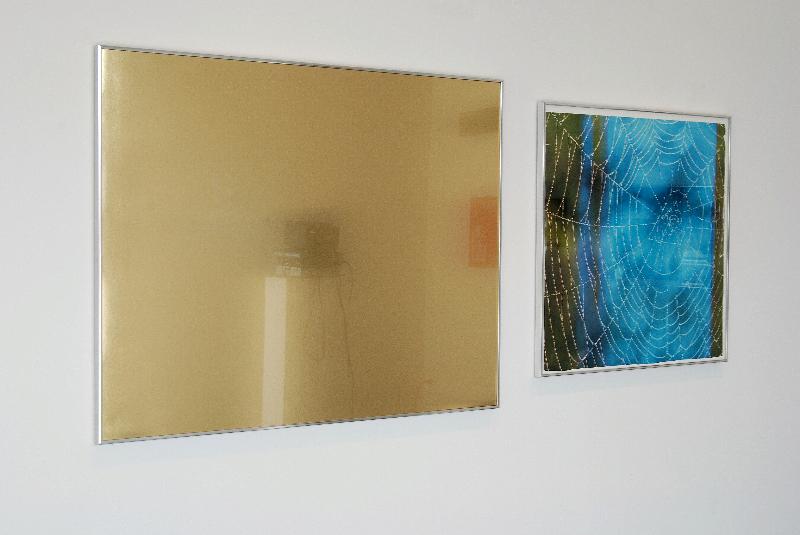Whitehot Magazine
September 2025
"The Best Art In The World"
"The Best Art In The World"
September 2025
May 2007, WM issue #3: Eduardo Consuegra @ Art Center Pasadena

When Will The End Come? The Go –Between And Vanity in the Afterlife.
Consuegras show contrived a feeling of conceit in me by association…I felt like it should be set in a lounge area, a living room situation, somewhere designed to flatter the vanities.
A looped video of a television stations globe- revolving titles logo? Running at less than ten seconds duration as a complete loop, is projected onto the white gallery wall. I feel as though we have been abandoned, one detects the recent presence of someone, persons having been here and left in mid-moment.
The video cannot end on its own and it runs infinitely into return, fated to immortality.
There's something similar to the feeling one might have of a dripping faucet or a system without governance as it cycles through repetition without end. It’s a worrying sense of perpetuity which is difficult to describe. When one becomes accustomed to the pointless but rhythmic familiarity there still remains the apprehensive question of ‘when?’ When will this change? When will this come to an end? When will time ‘run out’? when will the end come?
Consuegra was born and raised in Bogota, and his artwork, however transcontinental has often been grounded by his impressions of his native home. There are references to not only in material sources but implied gestures and innuendo much of which im sure I miss.
I do associate with the production and supply of our favorite stimulants, the Coffee, Cocaine and Cocoa all which provide a temporary fling with the vanities.
I imagine that it was not conceived of to have been eerie at the time of the advertising campaign but one commercial poster was a photorealistic hallucination of the fictional Colombian coffee industry mascot, Juan Valdez and his fictional mule, as an elaborate cobweb drawing upon whose silken structure droplets of water rest as though morning dew drops had condensed on it.
No clues to the intentions of the advertisers, nor is there a spider in this symbolic web.
A large white cubic form over a meter high and wide positioned on the floor of the exhibition is foam, painted opaquely with gloss white latex paint. A smooth and irregular pocked and bubbled surface. This object was a sneaky coup of horror. The cellular body of foam sealed within this permanent and asphyxiating surface.
The posters which are framed behind clean reflective glass are sassy Colombian advertisements appear dated from the eighties and nineties, with bleached and sun damaged patinas or are merely blank, one yellow, a metallic gold, one black,one white. Kittens, a female model attempting to appear seductive as she poses with a bottle of liquor…but besides the amateurish look to the whole gig, her expression betrays an anxiety as does the portrait of the male model. His styling is very gay and the model looks both blankly present and self consciously vain. The posters flawlessness has transformed as sunlight has degraded the ink.
Advertising photos are not made to be seen twice, age or exist at all after their brief appearance where they act as provisional apparitions.
In Consuegras work there is a Wildean suggestion of transference, of an exchange between pictures and people. Here the images, even the printed monochromatic colours, (of course! modernism!) seem to have been cast as stand –ins, as go-betweens.
The wreckage of vanity.
The allure of the appearance which actually hasn’t any body at all. How have we replaced the real with the image?. Beginning by not feeling real in the first place, by being a host to symbolism and psychotic self -constructions and repetitively reconstructing our mental appearance, often only as an adaptation to the flash of blurry likenesses in media.
There were some blurry reflective metallic papers in frames, open to the space. Reflective materials and surfaces are an Artists’ anti –image, while they simultaneously mirroring the exhibition space and its contents, people. Here it is not sharply focused but blurry, much like the technique in 20th century film and television which symbolized the recollection of memory with its incomplete and tunnel vision –like playback. In this room there is no time lapse and the reflected image plays out as live media. It is recycling us like a fountain pump while our fate revolves without closure, apparently transfixed as narcissus.
The proposition of the image culture is that while life ‘lives’ in this static transformation that death itself has become another stabilized abstract and incidental event …as if it could only occur by accident or by willful choice and will be of no consequence anyways.
The static properties of this dream apparatus were not made to be observed while out of motion and when they are, through neglect or abandonment the diversionary codification of time and self within these contrivances seems like a hideous projection playing on the screen of the real and barely comprehensible human drama of time and aging. the manic and continuous streaming of consciousness however fuzzy and vain does incur a heavy debt to a very real neurotic anxiety of change.
This is an ongoing and unfinished article.

Eli Langer
Eli Langer was born in montreal pq, 1967. He has various travel experiences and international painting shows to his credit. habitation: Toronto and Los Angeles.
elilanger@hotmail.com
view all articles from this author












